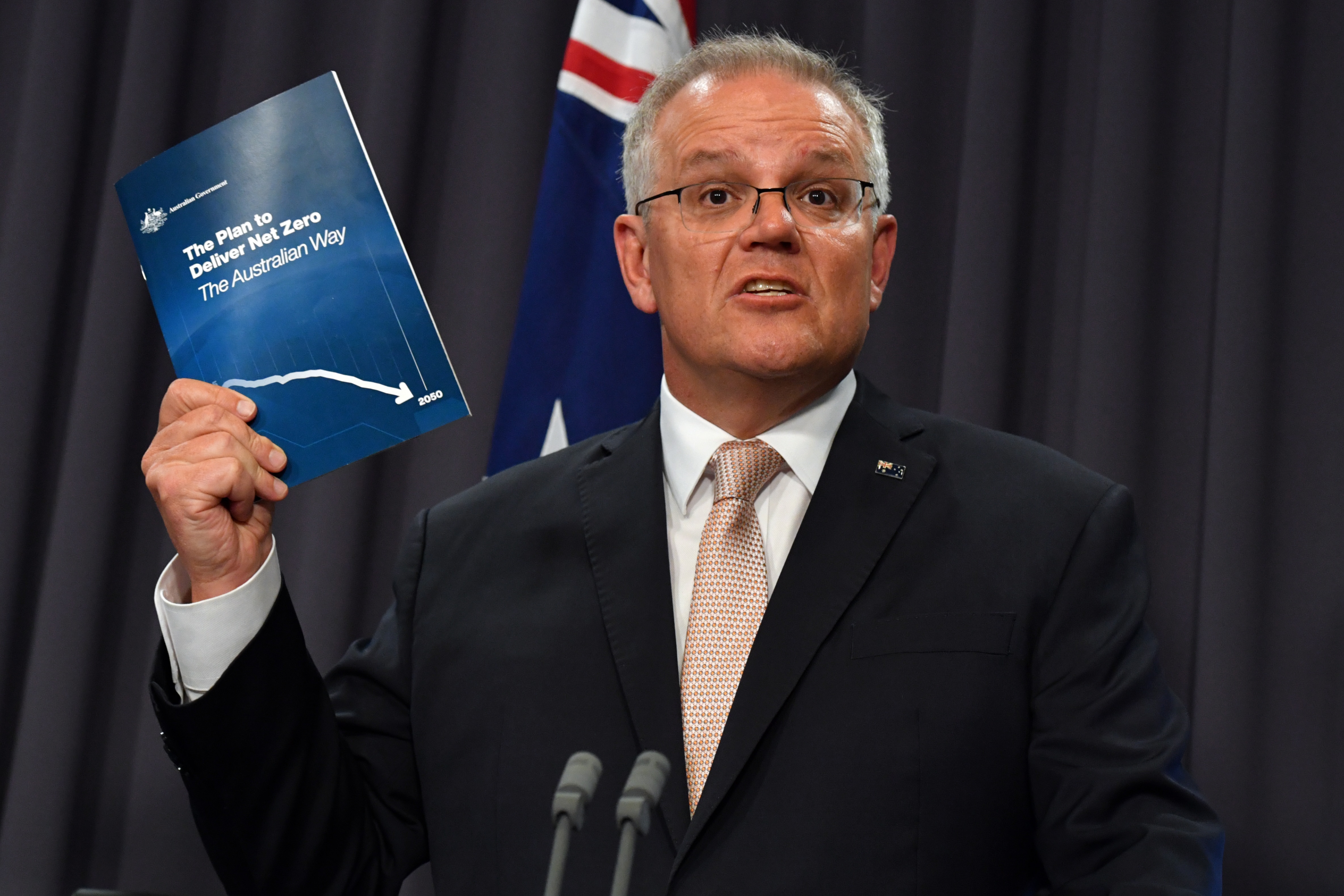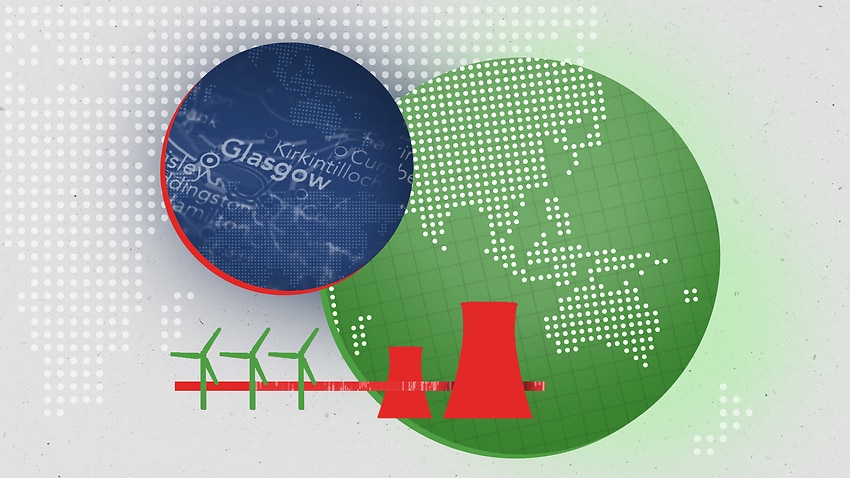This is how Scott Morrison plans to reach net zero emissions but not everyones convinced
The commitment from the Coalition has come only days before Mr Morrison leaves for the CO26 United Nations' climate summit in Glasgow.
But climate policy analysts are cautioning the response falls short on a lack of detail, public modelling and failure to formally commit to a stronger short-term target.
What is the government's plan?Fronting a press conference on Tuesday, Mr Morrison confirmed his government would go to Glasgow with the net zero target for midcentury.
Mr Morrison announced the policy alongside a slideshow and accompanying document describing the plan's response as "uniquely Australian".
"Our plan for net zero by 2050 is the plan I believe Australians want because it gets it right," he told reporters.
Scott Morrison unveils 'Australian way' plan for net zero
The plan outlines the government’s intention to spend $20 billion on low emissions technologies by 2030, focusing on investments in hydrogen, low-cost solar and low emissions steel and cement.
It’s also planning to invest in storing carbon underground through carbon capture and storage or sequestration.
This is expected to result in up to $60 to $100 billion in public and private investments over the same period.
"It's not a revolution, but a careful evolution to take advantage of changes in our markets," Mr Morrison said.
Grattan Institute Energy and Program director Tony Wood said the plan marked a step forward, but the technology roadmap didn't "cover the ground" required for a transition to net zero.
"This isn’t a plan to get to net zero by 2050 - this is a plan to develop technologies that will contribute to that," he told SBS News.
He described the response as "necessary," but not "sufficient" to reach the destination.
"If we are going to be serious about this we have to complement the target and the technology plan with the policies and financial markets to deliver it,†he said.
No change to 2030 targetThe government’s push to reach net zero by 2050 will be supported by an updated projection for 2030 to reduce emissions by 30 to 35 per cent.
But it won’t formally update its current official short-term target to reduce emissions by 26 to 28 per cent by 2030 on 2005 levels.
Countries had been called on to increase the ambition of the climate pledges ahead of the COP26 summit, with the United States promising a 50 to 52 per reduction and Britain 68 per cent by 2030.


Mr Morrison holds a document outlining his net zero emissions plan. Source: AAP
Some Pacific nations had also been pleading with Australia to cut harder its emissions sooner.
Professor Will Steffen from the Climate Council said Australia’s short-term response was unlikely to improve the reception of its response in Glasgow.
"We’ll still be at the laggard back of the pack - what Glasgow was really looking for is more ambitious targets," he told SBS News.
"Our standing will be still very low. In terms of the global mix, when we go into Glasgow.â€
How will Australia get to net zero?The government’s plan says Australia’s emissions have reduced 20 per cent since 2005 and explains how it expects the transition to net zero to be completed.
According to the plan, almost half of the remaining 80 per cent reduction would be secured through the technology roadmap.
Read More


Global "technology trends" are expected to account for 15 per cent of emissions reduction by 2050, while "international and domestic offsets" represent 10 to 20 per cent in cuts.
A further 15 per cent is expected to be achieved through "technological breakthroughs".
But the Australian Institute’s climate and energy program director Richie Merzian has raised concerns that the plan's reliance on offsets focuses too heavily on prolonging the life of fossil fuel industries.
"A good net zero by 2050 plan should be based on technology that works now not technology that supports fossil fuel industries to do less in the future," he told SBS News.
Can the plan achieve political consensus?Despite the net zero midcentury target now being unanimously agreed to by the Coalition and Labor, political division over climate policy has persisted in Canberra.
One point of contention is the government's decision not to reveal the modelling behind the plan, with Mr Morrison indicating this would be released at "another time".
Labor’s climate change spokesperson Chris Bowen said the policy response was "a scam" that did little to update the government's technology roadmap released last year.
"I’ve seen more details in fortune cookies than the documents released by the government today," he told reporters.
Read More


Opposition leader Anthony Albanese also wouldn't say if his party would adopt the Coalition's updated 2030 emissions projections as a target.
"What we've said very clearly is that we would await Glasgow and what comes out of Glasgow before we finalise all of our policies when it comes to climate change," Mr Albanese said.
The Greens, who want net zero by 2035, have also criticised the climate policy for not taking stronger-short term action.
How has it been received?The climate plan claims it will improve gross national income by 1.6 per cent compared with inaction, and floats the creation of 62,000 new roles in regional mining and heavy industry.
Australian Chamber of Commerce and Industry welcomed the "practical" response it said would help achieve the technological and economic transition towards net zero.
"Reaching net zero emissions by 2050 is an imperative for the Australian business community," Australian Chamber of Commerce and Industry chief executive Andrew McKellar said.
Business Council of Australia Chief Executive Jennifer Westacott added that the policy marked a chance to "draw a line under the last decade of division" on climate policy.
Read More


Under the plan, a review of the 2050 policy will be conducted every five years by the Productivity Commission, focusing on how rural and regional communities are coping with the transition.
The Nationals Farmers Federation (NFF) said by avoiding regulation and taxes - the government’s plan signalled an improvement on the past approach to the Kyoto climate agreement.
"What we still need to understand are those critical details negotiated within the Coalition," NFF president Fiona Simpson said.
The Minerals Council of Australia chief executive officer Tania Constable also said that the climate policy would ensure "stability" and "certainty" over the medium to long term.
But environment groups including Greenpeace and the Australian Conservation Foundation are concerned enough the response is not acting soon enough to cut emissions by 2030.







0 Response to "This is how Scott Morrison plans to reach net zero emissions but not everyones convinced"
Post a Comment